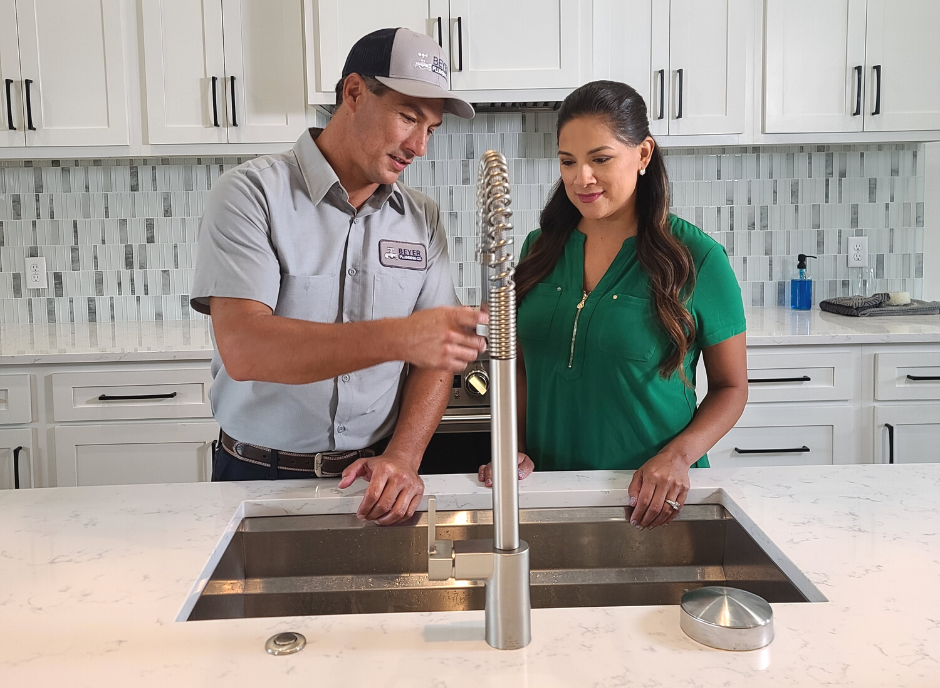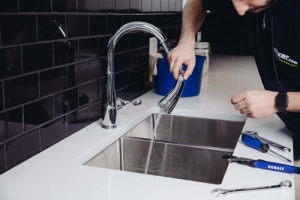An Benefits of Fixing a Dripping Faucet
An Benefits of Fixing a Dripping Faucet
Blog Article
What're your thoughts on Leaky Faucets: Why They Happen & What to Do About Them?

Trickling faucets could feel like a small aggravation, however their effect surpasses simply the aggravation of the noise. From wasting water to sustaining unnecessary monetary expenses and health and wellness risks, neglecting a dripping faucet can result in various consequences. In this article, we'll delve into why it's vital to resolve this common house issue without delay and effectively.
Wastefulness of Water
Ecological Effect
Trickling faucets add dramatically to water waste. According to the Epa (EPA), a single faucet trickling at one drip per secondly can squander greater than 3,000 gallons of water per year. This not just strains water resources but likewise influences ecosystems and wild animals dependent on them.
Step-by-Step Guide to Dealing With a Dripping Faucet
Tools Needed
Before trying to take care of a leaking tap, collect the essential tools, consisting of an adjustable wrench, screwdrivers, replacement parts (such as washers or cartridges), and plumber's tape.
Typical Faucet Issues and Their Solutions
Determine the type of tap and the details problem creating the drip. Common issues consist of damaged washing machines, corroded shutoff seats, or malfunctioning O-rings. Refer to maker guidelines or online tutorials for detailed assistance on repairs.
Financial Expenses
Raised Water Costs
Beyond the ecological effect, trickling faucets can inflate water bills substantially. The collected waste with time converts into higher energy expenditures, which could have been stayed clear of with prompt repair services.
Prospective Building Damages
Furthermore, prolonged dripping can result in damage to components and surfaces bordering the tap. Water buildup can cause discoloration, corrosion, and even structural concerns if left neglected, resulting in extra fixing prices.
Health Problems
Mold and Mold Development
The continuous visibility of wetness from a trickling faucet creates a suitable environment for mold and mildew and mildew development. These fungi not only compromise indoor air quality but also position wellness threats, specifically for people with breathing conditions or allergies.
Waterborne Illness
Stationary water in trickling taps can come to be a breeding place for germs and other microorganisms, increasing the danger of waterborne illness. Impurities such as Legionella microorganisms prosper in stationary water, possibly leading to serious ailments when ingested or breathed in.
DIY vs. Specialist Fixing
Pros and Cons of Do It Yourself Repair Service
While some might attempt to deal with a trickling tap themselves, do it yourself repair work feature their own set of obstacles. Without appropriate knowledge and tools, DIY attempts can exacerbate the problem or bring about incomplete repairs, lengthening the issue.
Benefits of Employing a Professional Plumber
Working with a professional plumber makes certain that the underlying root cause of the trickling faucet is addressed properly. Plumbing technicians possess the experience and devices to diagnose and repair tap issues efficiently, conserving time and minimizing the danger of more damage.
Ecological Duty
Private Payment to Conservation
Taking obligation for dealing with leaking taps aligns with wider initiatives toward water conservation and environmental sustainability. Every person's activities collectively make a considerable influence on preserving valuable sources.
Sustainable Living Practices
By prioritizing timely fixings and adopting water-saving routines, people add to lasting living practices that benefit both present and future generations.
Safety nets
Normal Upkeep Tips
To prevent leaking faucets, do regular upkeep such as cleaning aerators, examining for leakages, and changing worn-out components quickly. Furthermore, take into consideration installing water-saving devices or updating to more efficient fixtures.
Significance of Prompt Fixes
Resolving dripping faucets as quickly as they're observed protects against more water wastefulness and possible damages, inevitably saving both water and money in the long run.
Effect On Property Worth
Assumption of Well-Maintained Building
Keeping a residential or commercial property in good condition, including addressing upkeep concerns like trickling faucets, improves its perceived value and worth amongst prospective purchasers or renters.
Influence on Resale Worth
Features with properly maintained plumbing components, including faucets, command greater resale worths in the realty market. Addressing trickling taps can contribute to a favorable impression throughout building assessments and settlements.
Conclusion
Resolving a leaking tap goes beyond plain benefit; it's an important action toward preserving water, decreasing economic expenses, and safeguarding wellness and home. Whether through do it yourself repair work or specialist help, taking action to deal with leaking taps is a small yet impactful method to advertise responsible stewardship of sources and contribute to a healthier, more sustainable future.
How to Fix a Leaky Faucet: Step-by-Step Repair Guide
A leaky faucet may seem like a simple annoyance, but if it's not fixed promptly, that leak could cost hundreds to potentially thousands. From water damage to mold, mildew, and high water bills, even a tiny leak can be catastrophic if left unattended. Damage like this can even affect the overall value of your home, so it's important to take the right approach for leaky faucet repair. You may need the help of a plumber in some cases, but we've got a few tips you can try on how to fix a leaky faucet before calling the pros.
Four Faucet Types
When you're learning how to fix a leaky faucet, the first step is knowing what kind of faucet you're working with! There are four common types.
Cartridge Faucets
Cartridge faucets come in one- or two-handled varieties. In one-handled cartridge faucets, hot and cold water combines in a single cartridge. In the two-handled versions, hot and cold water are controlled separately and mixed in the faucet.
Ball Faucets
Ball faucets have a single lever you push up and down to adjust the pressure and rotate to change the temperature. A slotted metal ball controls the amount of water allowed into the spout.
Compression Washer Faucets
They're the oldest type of faucet, but they're still used in many homes — especially older ones. Compression faucets have two separate handles that, when turned, raise or lower the washer that seals a water valve. This valve stops water from flowing through the faucet when it is turned off.
Disc Faucets
Disc faucets rarely need to be repaired due to their maintenance-free design. The water flow is controlled by two discs — the upper one raises and lowers against a fixed lower disc, creating a watertight seal. If your disc faucet starts leaking, you may need to replace the seals or clean residue buildup from the inlets.
Fixing a Leaky Faucet
Step 1: Turn Off the Water
Whether you're learning how to fix a leaky bathtub faucet or how to fix a leaky kitchen faucet, always turn off the water supply to your working area when you're fixing a leak. The last thing you want is a flood added to your list of things to fix.
Look for the shutoff valves below your sink or around the tub and turn them clockwise to stop the water flow. If your faucet doesn't have shutoff valves, you may need to turn off the water for the whole house. Check to make sure it's off by turning the faucet on. If nothing comes out, you're ready to start the repair.
Step 2: Take Apart the Faucet
How you disassemble your faucet depends on the type of fixture you have. You can use a flathead screwdriver to remove the caps on top of the handle or handles for cartridge and compression faucets. Inside, you should see handle screws. Unscrew these with a screwdriver to remove the handle.
Disc- and ball-style faucets will typically have an inlet screw near the handle, and removing that will reveal the interior of the faucet.
Detach the Valve Stem
For cartridge- and compression-style faucets, you'll see the inner valve stem or cartridge once you remove the faucet handles. If you have a compression faucet, unscrew the brass valve stem. If you have a cartridge faucet, pull out the cartridge. If your cartridge has been in place for a while, it may require some tools or extra force to remove it due to mineral deposits.
Examine and Replace Parts
Once you've removed the parts, check them out to confirm what needs to be replaced. You may see corroded rubber washers, O-rings, stems, or cartridges. On a ball-style faucet, check the seats and springs for damage.
If you need to repair a leaky disc faucet, check the inlet and seals on the lower disc.
Once you determine what parts must be replaced, visit your local hardware store. Bring the damaged parts with you to ensure you can purchase the correct components to replace them.
Clean Valves and Faucet Cavity
If you've removed a stem or cartridge, you may notice mineral buildup in the faucet's threads. Use white vinegar to clean the valve seat by soaking it for a few minutes, then scrub it away with a soft toothbrush and rinse with warm water. You can also clean the interior of the faucet in the same way.
Reassemble the Faucet
Once your faucet is cleaned and the required parts have been replaced, it's time to reassemble it. Put the pieces back together and slowly turn the water supply back on. Doing this slowly is crucial because too much initial water pressure can damage the new hardware you've just installed.
https://homewarranty.firstam.com/blog/how-to-fix-leaky-faucet

We are very interested by Why It's Important to Fix Leaky Faucets and I am praying you appreciated our blog post. For those who enjoyed our article if you please consider to share it. I am grateful for your time. Return soon.
Report this page